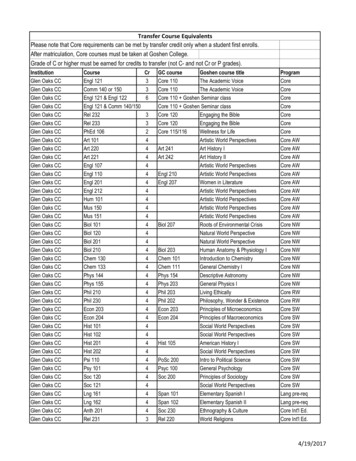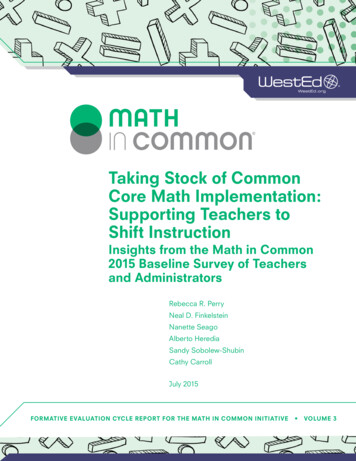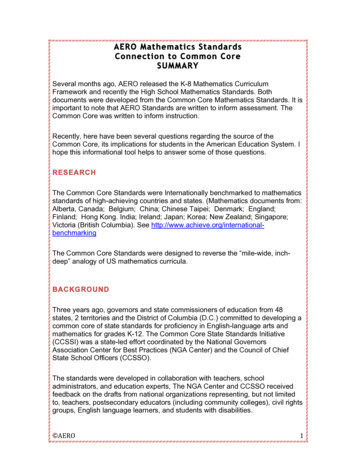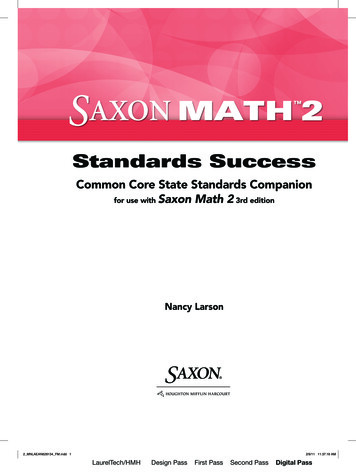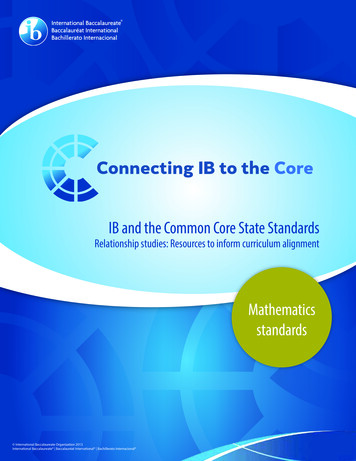
Transcription
IB and the Common Core State StandardsRelationship studies: Resources to inform curriculum alignmentMathematicsstandards International Baccalaureate Organization 2013International Baccalaureate Baccalauréat International Bachillerato Internacional
IB and the Common Core State StandardsRelationship studies: Resources to inform curriculum alignmentMathematicsstandardsWhat is an IB education?
Connecting IB to the CoreTable of ContentsIB and the Common Core State StandardsPublished July 2013Published on behalf of the International Baccalaureate Organization, a not-for-profiteducational foundation of 15 Route des Morillons, 1218 Le Grand-Saconnex, Geneva,Switzerland by theInternational Baccalaureate Organization (UK) LtdPeterson House, Malthouse Avenue, Cardiff GateCardiff, Wales CF23 8GLUnited KingdomPhone: 44 29 2054 7777Fax: 44 29 2054 7778Website: www.ibo.org International Baccalaureate Organization 2013The International Baccalaureate Organization (known as the IB) offers four high-qualityand challenging educational programmes for a worldwide community of schools, aimingto create a better, more peaceful world. This publication is one of a range of materialsproduced to support these programmes.The IB may use a variety of sources in its work and checks information to verify accuracyand authenticity, particularly when using community-based knowledge sources such asWikipedia. The IB respects the principles of intellectual property and makes strenuousefforts to identify and obtain permission before publication from rights holders of allcopyright material used. The IB is grateful for permissions received for material usedin this publication and will be pleased to correct any errors or omissions at the earliestopportunity.All rights reserved. No part of this publication may be reproduced, stored in a retrievalsystem, or transmitted, in any form or by any means, without the prior written permissionof the IB, or as expressly permitted by law or by the IB’s own rules and policy. Seehttp://www.ibo.org/copyright.IB merchandise and publications can be purchased through the IB store athttp://store.ibo.org. General ordering queries should be directed to the Sales andMarketing Department.Phone: 44 29 2054 7746Fax: 44 29 2054 7779Email: sales@ibo.orgForeword. iIntroduction. iiiAbout the IB. iiiAbout these resources. iiiThe Primary Years Programme and the Common CoreState Standards for mathematics. 1The Middle Years Programme and the Common CoreState Standards for mathematics. 13The Diploma Programme and the Common Core StateStandards for mathematics. 23The IB Career-related Certificate and the Common CareerTechnical Core. 33IB programmes and the Common Core State StandardsApplication to Students with Disabilities . 39Appendices. 44Bibliography. 51IB references. 52International Baccalaureate, Baccalauréat International and Bachillerato Internacionalare registered trademarks of the International Baccalaureate Organization.Common Core State Standards for mathematics
ForewordSince 1968 the small group of international school educators who founded the International Baccalaureate(IB) have been analysing best practices in the field ofeducation from around the world. They drew uponthese best practices in order to build what wouldbecome the IB’s Diploma Programme (DP). Today,over one million IB students from over 140 countriesare held to the same rigorous academic expectationsthat formed the building blocks of the DP 45 yearsago. The IB’s experience working flexibly within thediversity of national education systems and curriculums across a global platform make it a senior statesman in the field of broad, standards-based academicreform movements such as the Common Core StateStandards initiative (CCSS).The IB and the CCSS share many goals, the foremost ofwhich is their mutual emphasis on career and collegereadiness. An IB education not only holds students tothe highest academic standards but also incorporatesan understanding and appreciation of other culturesand points of view, and world language competency—precisely the soft skills in demand by the globaleconomy. IB students demonstrate a strong competency in the context of global readiness and are, notsurprisingly, sought after by colleges and universities for their soft skills as well as their hard-earnedacademic achievements.IB World Schools have an advantage when adoptingthe CCSS. IB standards were selected as one of fiveinternational benchmarks against which to comparethe CCSS in an influential study conducted by theEducational Policy Improvement Center (EPIC). TheCCSS represents a shift in teaching from covering awide breadth of content to a greater focus on depthof understanding and interdisciplinary approaches toteaching and learning. These very characteristics define what makes an IB education so effective. The shiftin thinking and practice that many IB schools madeArtwork by: Eleazar MendozaDwight D. Eisenhower High School11th Gradeon their journey to becomeIB World Schools are oftenthe same shifts schools willneed to make in transitioning to the CCSS.Our goal in undertaking these relationship studies isto support IB educators in their efforts to align theircurriculum to the CCSS. We are confident that thesestudies will provide a starting point to begin the important work of curriculum alignment in your ownschools and serve as a touchstone to reassure you thattransitioning to the CCSS will be that much easier dueto the hard work that you and your colleagues havealready done to meet the rigorous standards requiredto offer an IB education.Although the CCSS initiative is unique to the UnitedStates, it will impact standards-based reform movements everywhere. The IB contributes a long-respectedvoice in the field of international education, adding aglobal dimension to the discussion around the CCSS.The IB will continue to draw upon school reform initiatives around the world, such as the CCSS, to ensurethat it remains a leader in providing a pedagogicallycurrent international education based on research andbest practices.As always, we welcome your ideas and want to hearyour reflections and feedback. All materials relatedto the IB and the CCSS will be posted and can beaccessed through a dedicated webpage on the IBpublic website: http://www.ibo.org/iba/commoncore.All feedback related to the CCSS can be sent to a mailbox especially created to respond quickly to inquiries(commoncore@ibo.org).Warm regardsDrew DeutschDirector, IB AmericasCommon Core State Standards for mathematicsi
IntroductionAbout the IBAbout these resourcesThe IB continuum of international education for 3 to19-year-olds is unique because of its academic andpersonal rigour. Teaching and learning in all IB programmes— the Primary Years Programme (PYP),the Middle Years Programme (MYP), the DiplomaProgramme (DP) and the IB Career-related Certificate(IBCC)—grows from an understanding of educationthat celebrates the many ways people work togetherto construct meaning and make sense of the world.The IB recognizes that the implementation of theCommon Core State Standards (CCSS) will have a significant impact on public schools in the US and in IBWorld Schools around the globe that follow a US curriculum. In order to support IB World Schools as theyprepare for the CCSS, the IB commissioned studies toidentify the broad relationships that exist between theoverall expectations in the PYP mathematics scopeand sequence, the MYP and DP aims and objectivesfor mathematics and the K–12 CCSS for mathematics.An IB education is for the whole person, providing awell-rounded experience anchored by values and outcomes described in the IB learner profile. IB learnersstrive to become inquirers, knowledgeable, thinkers,communicators, principled, open-minded, caring, risktakers, balanced and reflective. These attributes of internationally minded people represent a broad range ofhuman capacities and responsibilities that go beyondintellectual development and academic success.The IB’s student-centred philosophy, with its focus onthe interplay between inquiry, action and reflection,empowers students for a lifetime of learning, both independently and in collaboration with others. An IBeducation centres on learners, develops effective approaches to teaching and learning, and explores significant content within global contexts.IB World Schools undertake rigorous authorizationand evaluation processes to offer one or more IB programmes. The IB Programme standards and practices is adocument that provides a set of criteria against whichboth the IB World School and the IB can evaluatesuccess in the implementation of the four programmes.This foundational document for schools and theIB ensures quality and fidelity in the implementation ofIB programmes.Artwork by: Alexandra PhilcoFDR American School of Lima12th GradeThe IB developed these studies in collaboration withIB educators, a hallmark of its relationship with its community. Educators with specialized knowledge of IBcurriculums and the CCSS for mathematics workedclosely with IB academic staff to produce these resources for the PYP, MYP and DP.The CCSS define what students in mathematics shouldunderstand and be able to do by the end of eachgrade. The PYP and MYP provide curriculum frameworks that are designed to meet the developmentalneeds of students. These curriculum frameworks andthe DP mathematics courses offer schools the flexibility to accommodate the demands of national or localrequirements for mathematics.Studies were commissioned to educators with specialized knowledge of IB curriculums and CCSS for mathematics. The purpose of these studies is to provideschools with a flexible resource to inform their owncurriculum alignment. The studies employ the structure of the eight common core standards for mathematical practice to highlight the broad relationshipwith teaching and learning about mathematics in thePYP, MYP and DP. They provide a snapshot of the relationships and are not intended to be comprehensivein nature.The IB anticipates that these resources will evolve withfurther implementation of the CCSS. IB educators willno doubt discover other aspects of the relationshipbetween teaching and learning in IB programmes andthe CCSS as they reflect upon their teaching and students’ learning.Common Core State Standards for mathematicsiii
The Primary Years Programmeand theCommon Core State Standardsfor mathematics
The Primary Years Programme and the Common Core State Standardsfor mathematicsThe PYP is designed for students aged3 to 12. It focuses on the development ofthe whole child as an inquirer, both in theclassroom and in the world outside.It is a framework guided by six transdisciplinary themes of global significance,explored using knowledge and skillsderived from six subject areas, as well asapproaches to learning with a powerfulemphasis on inquiry.The design of the PYP is sufficiently flexible to accommodate the demands of national or local curriculums asschools develop their own programme of inquiry (POI). Itfollows therefore, that as a flexible and rigorous curriculum framework, the PYP offers teachers the opportunity todevelop learning experiences for students that meet thedemands set out by the CCSS.The CCSS for mathematics “do not dictate curriculum orteaching methods” (NGA Center 2010: 5). The PYP, with itsinquiry-based pedagogy, provides an effective frameworkfor teaching and learning the CCSS.Common Core State Standards for mathematics3
The CCSS define what students should understand and be able to do by the end of each grade and the CCSSfor mathematics place an emphasis on applying mathematics to the real world. Mathematical instruction in the CCSS includes both the proficiency in, and processes of, mathematics.This following study employs the structure of CCSS to relate the eight standards for mathematicalpractice for kindergarten through grade five to a specific component of the PYP: the overall expectations and learning outcomes of the PYP Mathematics scope and sequence. The purpose is to provideschools with a resource to support their own curriculum alignment. The study demonstrates that thecurriculum framework of the PYP supports the implementation of the CCSS in mathematics for kindergarten through grade five.Introductory observationsThe CCSS are a shift in the direction of mathematics education. They move beyond traditional “standards” to a focus on applying mathematics to real-life situations. Students are no longer learning content as isolated facts, but rather as tools to solve a wide range of problems. This shift resonates withthe PYP Changes in mathematics practices (Appendix 2), which notes an increased emphasis on “real-lifeproblem solving using mathematics”.Both the PYP and the CCSS use strands of mathematics to structure learning progression. In the PYPMathematics scope and sequence the strands are: data handling, measurement, shape and space,pattern and function and number (Appendix 1).The strands are divided into four phases. Each phase further identifies the following stages studentstypically follow when learning mathematics: constructing meaning, transferring meaning intosymbols, and applying with understanding. The four phases form a developmental learningcontinuum detailing how students might move through the phases as they become more proficient in mathematics. It is important to note that these phases are not to be identified as gradeequivalents and should allow for developmental differences. This will enable teachers to moreaccurately identify current levels of each student’s development and plan learning experiencesaccordingly. The PYP Mathematics scope and sequence document states in the section “The structure ofthe PYP Mathematics scope and sequence” “ that the evidence of mathematical understandings aredescribed in the behaviours or learning outcomes associated with each phase and these learningoutcomes relate specifically to mathematical concepts, knowledge and skills. The learning outcomeshave been written to reflect the stages a learer goes through when developing conceptual understanding in mathematics—constructing meaning, transferring meaning into symbols and applyingwith understanding”.The CCSS are a shift in the direction of mathematics education.They move beyond traditional “standards” to a focus onapplying mathematics to real-life situations.4Primary Years Programme g withunderstandingFigure 1How children learn mathematicsThe CCSS for mathematics “set grade-specific standards” (NGA Center 2010: 4) of what students shouldunderstand and be able to do. The CCSS for mathematical content are divided into domains “whichare larger groups of related standards” (NGA Center 2010: 5) identified as operations and algebraic thinking, number and operations in base 10, measurement and data and geometry.Kindergarten also includes the domain of counting and cardinality.Both the CCSS and PYP identify the importance of conceptuallearning in mathematics. The conceptual framework of the PYPpromotes a deep understanding of mathematical principlesand the use of transdisciplinary themes ensures that connections with the real world are made.In the PYP, mathematics is viewed as a tool to support inquiry and provides a global language throughwhich students make sense of the world around them.Mathematics helps explain the why and how, and is aprocess of thinking. The overall expectations of PYPmathematics include processes and proficiency, as doesthe CCSS.The comprehensive philosophy and approach of the PYP’swritten, taught and assessed curriculum is highly visible withinthe eight “Standards for mathematical practice” as evidenced in thefollowing section.Common Core State Standards for mathematics5
Standards for mathematical practice3. Construct viable arguments and critique the reasoning of others.“Mathematically proficient students understand and use stated assumptions, definitions, andpreviously established results in constructing arguments” (CCSS 2010: 6).1. Make sense of problems and persevere in solving them.“Mathematically proficient students start by explaining to themselves the meaning of a problem and looking for entry points to its solution” (NGA Center 2010: 6).Both the PYP Mathematics scope and sequence and the “Standards for mathematical practice”recognize the many ways in which students construct mathematical understandings.Students learn mathematics by constructing meaning through ever-increasing levels ofabstraction, starting with exploring their own personal experiences, understandings andknowledge. The PYP Mathematics scope and sequence identifies constructing meaning as thefirst stage in all four phases in every strand. The PYP recognizes the need for students to learnusing concrete problems before they can work at an abstract level. The nature of learningthrough inquiry in the PYP naturally promotes making sense of problems and persevering insolving them.The PYP recognizes the need for students to learn using concreteproblems before they can work at an abstract level. The nature oflearning through inquiry in the PYP naturally promotes makingsense of problems and persevering in solving them.2. Reason abstractly and quantitatively.“Mathematically proficient students make sense of quantities and their relationships in problem situations” (NGA Center 2010: 6). When students truly understand mathematics conceptually, they can apply their mathematical understanding to a new problem and use mathematical symbols and language to explain their thinking. While the CCSS for mathematics explicitlyrefer to the ability to “decontextualize” and “contextualize”, development of this ability is implicitin all PYP mathematical strands and phases. Both the PYP Mathematics scope and sequenceand the “Standards for mathematical practice” have similar expectations of students to reasonabstractly and quantitatively.In order to be able to use mathematics as a tool, students need to be able to go from thespecifics of the situation to the more abstract mathematics underlying the problem. The PYPMathematics scope and sequence identifies the second stage in all four phases of every strandas “transferring meaning into symbols”. The third stage is to “apply with understanding”. Thesetwo stages in every strand move students’ understanding from the concrete to the abstract.6Primary Years Programme (PYP)Both the PYP Mathematics scope and sequence and the CCSS for mathematical practice encouragenot only that students are able to comprehend mathematical concepts and content, but alsoexhibit and demonstrate the processes and new understandings developed. Students explaintheir thinking using numbers, models, graphs, words and relationships. In addition, studentsshould then be able to apply new knowledge and understandings in a variety of situations thatallow for further understanding as well as the development of multiple perspectives.The PYP Mathematics scope and sequence encourages students and teachers to use certainprocesses of mathematical reasoning as they progress through the three stages of learningmathematics. These processes include: using patterns and relationships to analyse the problem situations upon which theyare working making and evaluating their own and each other’s ideas using models, facts, properties and relationships to explain their thinking justifying answers and the processes by which they arriveat solutions.In this way, students validate the meaning they construct from their experiences with mathematical situations. By explaining their ideas, theories and results, both orally and in writing, theyinvite constructive and critical feedback, as well as lay out alternative modelsof thinking for the class (see the section “What the PYP believes aboutlearning mathematics”).The IB learner profile attributes of communicator and thinkerfurther reinforce the construction of viable arguments andthe ability to critique the reasoning of others. The ability toconjecture and justify conclusions is essential if studentsare to be able to fully experience mathematics.4. Model with mathematics.“Mathematically proficient students can apply themathematics they know to solve problems arising ineveryday life, society, and the workplace” (NGA Center2010: 7).Both the PYP Mathematics scope and sequence and the CCSS formathematical practice require students to explain their answersboth by the use of estimation and by precise computation.Common Core State Standards for mathematics7
The PYP Mathematics scope and sequence reinforces that modelling using manipulatives provides a valuable scaffold for constructing meaning about mathematical concepts. It identifiesmodelling as one of the processes students and teachers use throughout the three stages oflearning mathematics. It is specifically mentioned as a way to develop conceptual understanding in the following strands: data-handling, shape and space and number.In the pattern and function strand, students progress in phase one to understand patternsand sequences in everyday situations. In phase two, they represent patterns using numbersand other symbols. In phase three, they sense real-life situations using mathematical representations. In phase four, symbolic rules are used to analyse and represent patterns.In the shape and space strand, students to use two-dimensional and three-dimensional modelsto explain properties of various shapes. In the number strand, students use fractions in real-lifesituations and use estimation to check the reasonableness of their answers.PYP educators provide regular opportunities for students to use a range of manipulatives aswell as discuss and negotiate their developing understanding with others.PYP educators provide regular opportunities for studentsto use a range of manipulatives as well as discuss andnegotiate their developing understanding with others.5. Use appropriate tools strategically.“Mathematically proficient students consider the available tools when solving a mathematical problem” (NGA Center 2010: 7). Mathematics has always relied on tools of some form, forexample, paper and pencil, slide rule or computer software. The goal is to help students knowwhen and how to use tools appropriately. Both the PYP Mathematics scope and sequence andthe CCSS standards for mathematical practice encourage students to employ appropriatetools. This includes using technology to solve real-life problems in a strategic and meaningfulmanner that will assist with the development of mathematical concepts within a relevant context.Learners are asked to integrate new mathematical knowledge in a variety of situations thatrequire in-depth understanding and application of new learning.Use of mathematical tools is evident throughout the PYP, and provides authentic opportunitiesfor students to interact in realistic contexts with mathematical tools playing a key role. The useof tools is encouraged and evident in the PYP Mathematics scope and sequence strands andis particularly emphasized in the data handling and measurement strands. For example,in the measurement strand in phase three, students “select and use appropriate tools andunits of measurement” and in phase four learners “develop and describe formulas to find area,perimeter and volume” (see the section “Learning continuum for measurement”). In the datahandling strand, students in all phases learn how to sort, categorize and interpret data with avariety of charts and graphs. By phase three and four, students are able to choose which typeof graph best depicts the data for representation (see the section “Learning continuum for datahandling”).8Primary Years Programme (PYP)The PYP Mathematics scope and sequence notes that while tools commonly used should beutilized in authentic ways to solve problems, care should be taken to ensure that studentshave a strong understanding of the concepts embedded in the problem to ensure meaningfulengagement with the tools and develop a fuller understanding of the solution posed. Doingso ensures that students use appropriate tools strategically.The goal is to help students know when and how to use toolsappropriately. Both the PYP Mathematics scope and sequenceand the CCSS standards for mathematical practice encouragestudents to employ appropriate tools. This includes usingtechnology to solve real-life problems in a strategic andmeaningful manner that will assist with the development ofmathematical concepts within a relevant context.6. Attend to precision.“Mathematically proficient students try to communicate precisely to others” (NGA Center 2010: 7).Both PYP mathematics and the CCSS for mathematics recognize the importance of communicating mathematical concepts and understandings in an effective, knowledgeable manner.The two mathematics courses also require students to communicate precisely usingmathematical terminology, including labels and notation. Attention to detail when recordingmathematical data and solutions is essential to both, and students are providedwith multiple opportunities to ensure attention to the recording andreporting of data and information.Artwork by: Emma DowneyCaldwell Heights Elementary2nd GradeThe PYP Mathematics scope and sequence recognizes that inorder to be useful, number facts (for addition, subtraction,multiplication and division) must be recalled automaticallywith precision. The PYP notes that the degree of precisionneeded when calculating depends on how the resultwill be used. In the PYP data handling strand, as earlyas phase one, students use tally marks or pictographs toaccurately depict data. Phase four of the measurementstrand addresses precision in the degree of accuracy fortheir measurements as well as their mathematical notation.In the number strand, students have automatic recall of factsand use strategies to solve problems and check for accuracy.Phase four of the shape and space strand requires students to use scale accurately to enlarge and reduce shapesas well as encouraging them to create and manipulate shapes.By doing this, students align their natural vocabulary with moreformal mathematical vocabulary and begin to appreciate the need forthis precision.Common Core State Standards for mathematics9
7. Look for and make use of structure.Summary“Mathematically proficient students lookclosely to discern a pattern or structure”(NGA Center 2010). Both the PYPMathematics scope and sequence andthe CCSS for mathematical practicerequire students to utilize patterns toexplain mathematical thinking in geometry and with numbers. The pattern andfunction strand in the PYP Mathematicsscope and sequence sets expectations ineach phase that students will look for, andmake use of, structure. The guide also notesthat “By analysing patterns and identifying rules forpatterns it is possible to make predications” (see thesection “Learning continuum for pattern and function”).In the number strand, students use operations and the order ofoperations to solve problems. In the data handling strand, students gather and displayvarious types of data, seek ways in which best to represent that data and learn to identifypatterns in order to analyse data.The areas of convergence between the requirements of the CCSS for mathematical practice andthe PYP Mathematics scope and sequence are evident upon review. While the phases of learning thatexist within the PYP are more developmental in nature, both the PYP and the CCSS require attention tothe important processes of learning and the ability to communicate new understandings.In the PYP Mathematics scope and sequence shape and space strand, students learn the properties of regular and irregular polyhedra and can use models to visualize real world situationsby phase four. Students are able to use ratios and scale to create models to explain larger orsmaller shapes.With the implementation of the CCSS for mathematical practice, IB practitioners will discover otheraspects of the relationship between the PYP Mathematics scope and sequence and the CCSS as theyreflect upon their teaching and students’ learning.8. Look for and express regularity in repeated reasoning.“Mathematically proficient students notice if calculations are repeated, and look both for generalmethods and for shortcuts” (NGA Center 2010: 8).The study also highlights some areas of distinction in the PYP that are identified by commitment tothe development of international-mindedness and student-led inquiry, which are essential to the PYPand provide opportunities for students and teachers to appreciate the global dimension of mathematics. The IB learner profile, together with the five essential elements of the PYP—knowledge, concepts,skills, attitudes and action—informs all planning, teaching and assessing in the PYP. The PYP approaches to learning coupled with the learner profile promote the qualities expected in 21st century learnersand international-mindedness.As students investigate mathematics and its application to the real world, the PYP provides anauthentic framework for expl
develop learning experiences for students that meet the demands set out by the CCSS. The CCSS for mathematics "do not dictate curriculum or teaching methods" (NGA Center 2010: 5). The PYP, with its inquiry-based pedagogy, provides an effective framework for teaching and learning the CCSS. Common Core State Standards for mathematics
